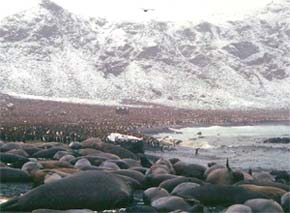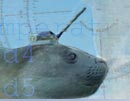Background
It is known that there are a number of significant breeding colonies, the largest being at Macquarie, Kerguelen, and at South Georgia. Conventional studies have provided valuable information about southern elephant seal numbers when they are at their colonies, and have shown that seals tend to return to the same colony every year.
|
Breeding penguins and seals have now re-occupied a C19th blubber boiling site on Macquarie Island  
The southern elephant seal was hunted until the 1950s. Despite the end of hunting, the populations of the Kerguelen and Macquarie colonies continued to decline during the 1950s, 60s, and 70s. It is not known exactly why this happened, although this did coincide with a period of decline of the extent of sea ice. However, during the same period, the South Georgia based population was stable.
|
| |
It is yet not clear whether current changes in the population at Kerguelen and Macquarie are due to an actual change from the 2% per year decline, or simply statistical ‘noise’. 2% per year may seem like a small amount, but it is cumulative, and if that trend was to continue, there would be no southern elephant seals at Kerguelen and Macquarie by 2040.
|
The shading emphasises the ranges of seals from different colonies, illustrating that there are also some regions of overlap.
|
This map marks six key southern elephant seal breeding
colonies and shows how their populations form
an almost complete circumpolar arc.
The radiating coloured tracks summarise the results of
SEaOS taggings.
Colours indicate where animals were tagged.
| |
Green tracks |
Seals tagged in the South Shetland Islands colonies. Some of these seals breed at South Georgia, and some on the South Shetland Islands. |
| |
|
| |
Orange tracks |
Seals tagged at South Georgia |
| |
Red tracks |
Seals tagged at Macquarie |
| |
Yellow tracks |
Seals tagged at Kerguelen |
|
|
What happens at sea?
What SEaOS has been able to contribute to assist conservation of the southern elephant seal, is information about where the seals go when they are not at their colonies, and about the nature of the conditions encountered while in these ranges. This is important, as the seals spend around 85% of their time at sea, and, whatever it is that is causing the populations of Kerguelen and Macquarie to decline, it does not appear to be something which happens at the colonies.
From the SEaOS studies, is has become apparent that southern elephant seals from each colony favour specific conditions, for example regions of marginal ice, or 'frontal' regions in the ocean. This is reflected in the diagram, which was made by creating summaries of all elephant seal expeditions studied over a two year period.
 Given that we know that southern elephant seals from different colonies go to specific ocean ‘ranges’ to feed, and given we know that their populations do not seem to be suffering adverse conditions on land, we can assume that there is something happening in the ocean ranges of the populations of Kerguelen and Macquarie which has a detrimental effect on their breeding success. Given that we know that southern elephant seals from different colonies go to specific ocean ‘ranges’ to feed, and given we know that their populations do not seem to be suffering adverse conditions on land, we can assume that there is something happening in the ocean ranges of the populations of Kerguelen and Macquarie which has a detrimental effect on their breeding success.
We do not know what is affecting these seals, however, due to SEaOS, we now have a clearer idea of the ocean conditions which they favour. The size and location of these favoured feeding areas may vary from year to year. We suspect that the distance from colonies to favoured feeding conditions may be an important factor in breeding success. |


![]()
